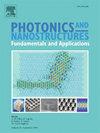Ultrafast pulse generation at 115 fs with a high peak power of 0.24 MW aided with Bi2Te3 2D nanomaterials
IF 2.5
3区 物理与天体物理
Q3 MATERIALS SCIENCE, MULTIDISCIPLINARY
Photonics and Nanostructures-Fundamentals and Applications
Pub Date : 2025-02-01
DOI:10.1016/j.photonics.2025.101351
引用次数: 0
Abstract
The generation of mode-locked pulses in the femtosecond region with high output power has shown its demand in various applications, such as laser cutting. Traditional active mode-locking approaches, such as acousto-optic modulators, can be challenging, particularly in timing setups. Alternatively, a semiconductor saturable absorber mirror (SESAM) was used in the passive approach. Yet, its cost and sensitivity to high-humidity environments led to the adoption 2D nanomaterials, which offer robust systems with notable modulation depths. Despite these advancements, most mode-locked lasers using 2D nanomaterials produced pulses in the picosecond region with average output power in the milliwatts (mW) range, limiting their applications. This work addresses the need for higher output power, which presents a detailed methodology for generating stable mode-locked pulses at 1 µm, achieving an average output power > 690 mW, a signal-to-noise ratio (SNR) of 52 dB, and a pulse width of 115 fs. Utilizing Bi2Te3 as a 2D nanomaterial saturable absorber, this work demonstrates a significant improvement in pulse stability and SNR, highlighting the potential for advanced applications.
求助全文
约1分钟内获得全文
求助全文
来源期刊
CiteScore
5.00
自引率
3.70%
发文量
77
审稿时长
62 days
期刊介绍:
This journal establishes a dedicated channel for physicists, material scientists, chemists, engineers and computer scientists who are interested in photonics and nanostructures, and especially in research related to photonic crystals, photonic band gaps and metamaterials. The Journal sheds light on the latest developments in this growing field of science that will see the emergence of faster telecommunications and ultimately computers that use light instead of electrons to connect components.

 求助内容:
求助内容: 应助结果提醒方式:
应助结果提醒方式:


